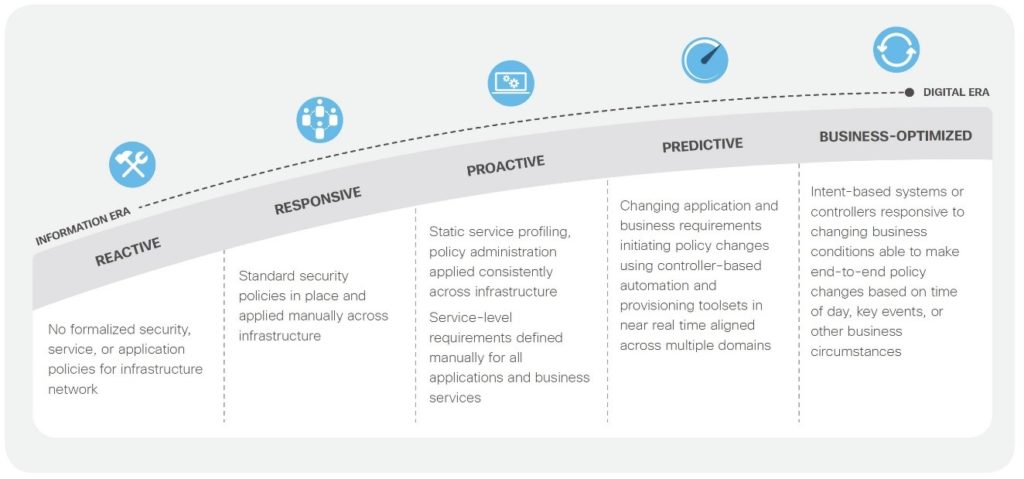Leading-edge networks—your network—can have the ability to comprehend business and application requirements and translate them to network and security policies. This ensures that your business critical services are continuously delivered and protected. We call it intent-based networking.
Get started by looking at your network. Find things you can upgrade and look for solutions for things you can’t change – like maybe your building.
The well-worn groove of habit.
Your network is more than just a convenience.
Ask Costco. Their retail Web-site went unresponsive for 16 ½ hours over this year’s critical Thanksgiving/Black Friday buying frenzy that estimates say cost them nearly $11M.
That’s over $11,000 a minute.
You also know it is time to take control of your network before it controls you. Or maybe it already does.
According to Cisco’s recent 2020 Global Networking Trends Report, 73% of those surveyed spend more than half their time just maintaining the status quo of their network. And it is not going to get any easier if status quo is manually configuring your network switch by switch, router by router, device by device.
At some point you know, it is time for something new. But how do you get started?
Digital technology is coming to a building near you soon.
Get started by looking at your network. Find things you can upgrade and look for solutions for things you can’t change – like maybe your building.
A common belief is that unless you are in a new building with the latest physical network “plumbing” you are all but stuck. Making your building “smart” is out of reach as “rewiring” an older building, at $200 to $1,000 per port, is hard to justify.
And guess what, you are not alone. Nearly 85% of commercial space is still using copper Ethernet cabling as the primary transport medium. This presents both a challenge and an opportunity.
The key challenge has been that Cat5e cabling was limited to 1G throughput. This meant that next generation W-Fi 6 and 802.11ac Wave 2 wireless technology wasn’t coming to your building. Cisco recognized the issue early on and added a hidden super power – Cisco Multigigabit or mGig. Leading NBASE-T technology standardization (now part of IEEE) Cisco Multigigabit technology takes speeds up to 10G and is becoming a foundational offering across all the Catalyst 9000 switching portfolio with new options on the Catalyst 9200, Catalyst 9300 and Catalyst 9600 Series switches.
The key opportunity is that same ethernet cable infrastructure can be used to power and control all sorts of new aspects of your work space. Flexibility, lower energy costs and often local, regional and federal regulatory demands are motivating building owners and designers to have a hard look at next generation digital buildings technologies. At the very foundation of many digital buildings is another hidden super-power: Power over Ethernet. And again, Catalyst 9000 switches give you a foundational starting point for now and the future with 90W Cisco UPOE+. While PoE has been a staple in offices world-wide, 90W PoE opens a whole new world of options from LED lighting, occupancy sensors, alarm systems and cameras to powering monitors, window shades and USB-C capable laptops. There are many well documented successes of retrofitted buildings that are better able to meet sustainability goals using data from a fully IoT-enabled building, and have greater command and control of the space.

A stellar example and early adopter of 90W Cisco UPOE+ is the Marriot Sinclair in Austin, Texas. They have reported that integrating HVAC, shades and lighting controls into their IT network have cut energy usage by over 40%. IoT sensor-based “occupancy” management saved an additional 30% in energy usage.
While Sinclair’s primary mission was to lead the way in digitally transforming the hotel experience, they knew that by using PoE they could monitor energy use and in turn improve energy conservation.
Others, like PineBridge Financial, have been able to combine their IT and OT platforms in their newly built office space, dramatically reducing their construction costs while cutting their electric bills by 2/3rds.
5 steps to intent-based networking
While we know you can’t just flip a switch (no pun intended) and turn on an intent-based network, Catalyst 9000 switches can help you create a foundation to take you there. Not only do these switches build upon the Catalyst legacy of reliability and scalability you have come to expect, but they are ready for things you didn’t expect.
Over the next few weeks I will take you on step-by-step approach to evolve your network from reactive to business-optimized, building upon a foundation of Catalyst 9000 to exploit analytics, automation and AI technologies.
But this is just the start. Like many, you are still in the “reactive zone”. But according the 2020 Global Networking Trends Report survey, over 70% of you want to have your network be predictive or business-optimized in two years.
The next step will likely be an easy skip rather than a jump. And it is almost as simple as flipping a switch. And doing so may be the difference between a network that needs continuous attention and one that simply understands what you need.
We call it Cisco DNA Assurance.
Make your intent-based network do more with the multidomain architecture
Find out more:
- Cisco Catalyst 9000 – The best keeps getting better.
- Catalyst 9000 Wireless and Switching Family
- 90W Cisco UPOE+ technology
- Multigigabit technology




Very good read!